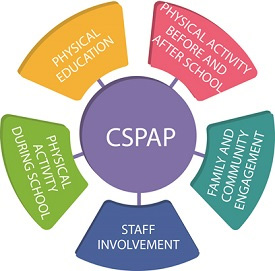
What is CSPAP?
 Schools play a vital role in ensuring children and adolescents get the nationally recommended 60 minutes of physical activity each day. Through the Whole School, Whole Community, Whole Child (WSCC) model, schools can provide many opportunities for students to be physically active. The WSCC model includes physical education and physical activity and the Comprehensive School Physical Activity Program (CSPAP) is a framework for planning and organizing activities this component. A CSPAP is a multi-component approach by which school districts and schools use
all opportunities for students to be physically active, meet the
nationally-recommended 60 minutes of physical activity each day, and
develop the knowledge, skills, and confidence to be physically active
for a lifetime. A CSPAP reflects strong coordination and synergy across
all of the components: physical education as the foundation; physical
activity before, during, and after school; staff involvement; and family
and community engagement.
Schools play a vital role in ensuring children and adolescents get the nationally recommended 60 minutes of physical activity each day. Through the Whole School, Whole Community, Whole Child (WSCC) model, schools can provide many opportunities for students to be physically active. The WSCC model includes physical education and physical activity and the Comprehensive School Physical Activity Program (CSPAP) is a framework for planning and organizing activities this component. A CSPAP is a multi-component approach by which school districts and schools use
all opportunities for students to be physically active, meet the
nationally-recommended 60 minutes of physical activity each day, and
develop the knowledge, skills, and confidence to be physically active
for a lifetime. A CSPAP reflects strong coordination and synergy across
all of the components: physical education as the foundation; physical
activity before, during, and after school; staff involvement; and family
and community engagement.
CDC, in collaboration with SHAPE America, developed a step-by-step guide for schools and school districts to develop, implement, and evaluate comprehensive school physical activity programs.
The goals of a CSPAP are:
- To provide a variety of school-based physical activities to enable all students to participate in 60 minutes of moderate-to-vigorous physical activity each day.
- To provide coordination among the CSPAP components to maximize understanding, application, and practice of the knowledge and skills learned in physical education.